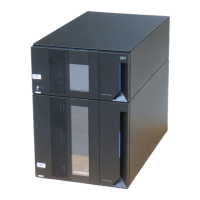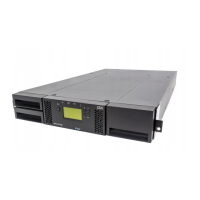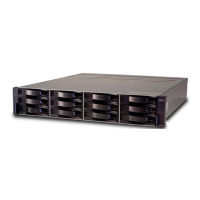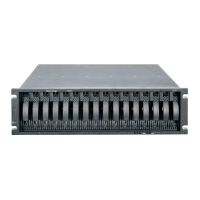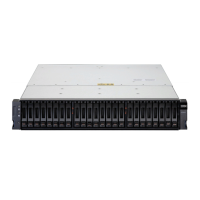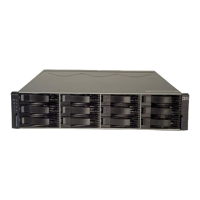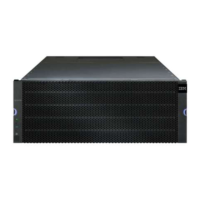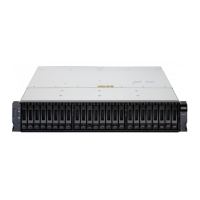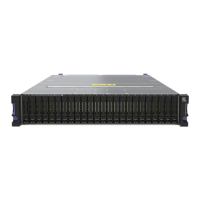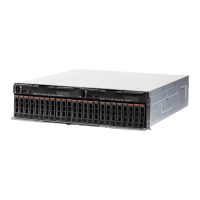Why is the IBM Storage login screen delayed during firmware update?
- JJonathan MatthewsSep 8, 2025
When the Library firmware is being updated on your IBM Storage, additional time is required before the login screen appears.
Why is the IBM Storage login screen delayed during firmware update?
When the Library firmware is being updated on your IBM Storage, additional time is required before the login screen appears.
How to fix a blank operator panel on IBM System TS3400 Tape Library?
To resolve a blank, hung, frozen, or visually distorted Operator Panel display on your IBM Storage (including incorrect or missing characters, dim display, or non-responsive control keys): * First, verify that power is being supplied to the library. * Next, gather failure information by logging into the Web User Interface and navigating to Service Library ? View Library Logs. * Then, cycle the library power. * Confirm that you are using the latest library and drive firmware versions, and upgrade if needed.
How to check for firmware issues on IBM System TS3400 Tape Library?
If you suspect a firmware problem with your IBM Storage, verify that you are running the latest versions of library and drive firmware by checking the Operator Panel revision. If updates are available, proceed with the upgrade process.
What to do if IBM System TS3400 Tape Library Storage Library firmware is hung?
If the IBM Storage Library firmware does not complete the boot-up process and appears hung, power OFF the library. Wait at least one minute, and then power it back ON to attempt recovery. If a library firmware update was recently performed, try repeating the update procedure.
How to troubleshoot error messages on IBM System TS3400 Tape Library?
To resolve an error message on your IBM Storage, begin by checking the error message displayed on the Operator Panel. If you find an error code, consult the “Error Codes” section on page 1-5 of the manual. Also, check the status of the cartridges, accessor, and drives through the view window. Power cycle the library. Ensure that the drive canisters are properly seated in the library.
What happens if I change drive type in IBM System TS3400 Tape Library?
If you change the drive type or position in the library of your IBM Storage, resubmit encryption settings.
How to troubleshoot encryption errors on IBM Storage?
If an encryption-related error is posted on your IBM Storage, check the host application’s error logs, device driver logs, tape library error logs, and tape drive error logs for entries that are related to encryption.
Why can't IBM Storage connect to the Encryption Key Manager?
If there is a connection problem with the Encryption Key Manager (EKM) on your IBM Storage, and you are using library-managed encryption, perform the Key Path Diagnostic. If the test fails, a problem could exist with the IP address, the Ethernet cable, or the EKM server.
What to do if IBM System TS3400 Tape Library Storage cannot read a bar code label?
If a bar code label cannot be read on your IBM Storage, first confirm that the bar code label is not damaged or missing. If needed, attach an IBM bar code label to the cartridge.
Why is the tape damaged inside my IBM Storage cartridge?
If tape inside a cartridge is broken, stretched, folded over, or wrinkled in your IBM Storage, instruct the customer to replace the tape cartridge. Also, ensure that the latest available drive code is installed.
| Type | Tape Library |
|---|---|
| Supported Media Types | LTO Ultrium 7, LTO Ultrium 8, LTO Ultrium 9 |
| Supported Tape Drives | LTO Ultrium 7, LTO Ultrium 8, LTO Ultrium 9 |
| Library Management | Web-based GUI |
| Model | IBM System Storage TS3400 |
| Connectivity | SAS |
| Tape Drive Technology | Linear Tape-Open (LTO) |
| Data Transfer Rate (LTO Ultrium 7) | 300 MB/s |
| Data Transfer Rate (LTO Ultrium 8) | 360 MB/s |
| Data Transfer Rate (LTO Ultrium 9) | 400 MB/s |
| Capacity (LTO Ultrium 7) | 6 TB |
| Capacity (LTO Ultrium 8) | 12 TB |
| Capacity (LTO Ultrium 9) | 18 TB |
| Encryption | Yes |
| Operating Temperature | 10 to 35 °C |
| Operating Humidity | 20% to 80% non-condensing |
| Form Factor | Rack-mounted |
| Interface | 6 Gbps SAS |
| Power Supply | Dual, redundant power supplies |
| Non-Operating Temperature | -40°F to 140°F (-40°C to 60°C) |
| Non-Operating Humidity | 10% to 90% non-condensing |
Guides users through diagnosing and resolving issues with the tape library and its components.
Lists and explains library error codes, their panel indications, and required actions for resolution.
Details error codes specific to the tape drives, including their descriptions and required actions.
Lists error messages generated by the Web User Interface and their corresponding issuing panels.
Explains TapeAlert flags supported by the library and associated tape drives, providing action requirements.
Describes how to use IBM device drivers to examine sense data for error determination and troubleshooting.
Identifies and describes the components located on the front panel of the TS3400 Tape Library.
Details the Operator Panel's display, menu structure, and control keys for library interaction.
Explains the function and physical connections of the Library Control Blade.
Describes the supported IBM tape drives and their physical characteristics and installation.
Explains the redundant power configuration and components of the TS3400 Tape Library.
Details the numbering system for library components, illustrating cartridge slots and drive locations.
Describes the types of data cartridges and cleaning cartridges supported by the TS3400 Tape Library.
Provides physical, electrical, environmental, and performance specifications for the library.
Identifies and details the components visible on the front panel of the tape library.
Describes the TS3400 Tape Library's two cartridge magazines and their slot configurations.
Explains the function of the I/O Station for importing and exporting cartridges without interrupting library operation.
Explains the physical connections and function of the Library Control Blade.
Details the tape drive, its canister, and associated LEDs for status indication.
Describes the Accessor assembly, its function in robotic movement, and its components.
Explains the drive docking card as the connection interface between the library control circuit and tape drives.
Details the Operator Panel's display, menu structure, and control keys for library interaction.
Explains the library's status display, including icons for accessor, drive, and cartridge status.
Describes the user login process for the Operator Panel, including default credentials.
Outlines requirements and access procedures for the Web User Interface for remote library management.
Explains the different user privilege levels for library access control.
Explains danger notices, their symbols, and their meaning regarding potentially lethal electrical conditions.
Details caution notices, associated symbols, and their meaning regarding hazardous conditions.
Identifies potential electrical, mechanical, and chemical hazards associated with the library.
Provides essential preparation steps and safety precautions before starting any work on the library.
Provides a step-by-step safety inspection procedure to be performed before servicing the library.
Offers general safety guidelines for installing and servicing devices within rack cabinets.
Provides criteria for selecting a suitable location for installing the TS3400 Tape Library.
Lists the items to verify in the library shipment to ensure all necessary components are included.
Details the procedure for removing components to reduce the library's weight for installation.
Guides the user through the process of installing the library into a standard 19-inch rack system.
Provides instructions on how to connect the power cords to the library's power supply units.
Describes how to verify that the library and its installed drives are operating correctly.
Provides instructions for connecting the host interface and network cables to the library.
Explains how the library detects, reports, and notifies users about problems using self-tests and LEDs.
Outlines the typical steps involved in servicing a library, from connecting to logging.
Describes the Service Mode menu options available on the Operator Panel for diagnostics and maintenance.
Details the procedure for running the critical Library Verify diagnostic test for performance assurance.
Explains how to connect a laptop to the library's Ethernet port for Web User Interface access.
Describes diagnostic and log download functions accessible via the Web User Interface for Service Users.
Explains the meaning of the light-emitting diodes (LEDs) on library components for status indication.
Guides users on downloading drive logs using the Web User Interface for troubleshooting.
Provides procedures for offloading drive data dumps to various systems using TAPEUTIL.
Details methods for updating drive microcode using tools like ITDT, NTUTIL, and TAPEUTIL.
Explains how to update drive microcode using the IBM TotalStorage Diagnostic Tool (ITDT).
Describes how to test tape device attachment to a Linux system using tapeutil.
Details how to check channel attachment for Windows NT/2000 systems using ntutil.
Explains procedures for downloading dumps or microcode via Ethernet for specific drive models.
Lists the field replaceable units (FRUs) of the TS3400 Tape Library and their reference information.
Specifies the required library status (e.g., Power OFF, Online) for servicing different parts.
Provides step-by-step instructions for removing and replacing a power supply unit.
Details the procedure for removing and replacing the Library Control Blade.
Guides on replacing a tape drive canister or removing it using FC 1663.
Provides instructions for removing and replacing the front bezel of the library.
Details the procedure for removing and replacing the LCD display card.
Outlines the steps for removing and replacing the entire Accessor assembly.
Details how to manually remove a stuck tape cartridge from a drive when other methods fail.
Provides a table to log service activities, including date, representative, parts exchanged, and description.
Lists available features for the library and their corresponding feature codes.
Lists library FRUs with their part numbers, essential for replacement.
Illustrates power cord plugs and lists corresponding country/region information and index numbers.
Explains how to retrieve error information from RS/6000 hosts using errpt commands.
Defines SCSI sense data fields and provides examples for library and drive errors.
Illustrates a SCSI Sense Data example for a library error, detailing probable causes and actions.
Provides an example of SCSI Sense Data for a tape drive failure, highlighting FID and ASC/ASCQ.
Guides on retrieving error information from Sun Systems via syslog.
Guides on retrieving error information from HP-UX Systems via syslog.
Lists encryption-related sense data, impact, explanation, and customer actions for troubleshooting.
Describes accessibility features for the HTML version, including keyboard navigation and screen reader support.
Explains how to use keys or key combinations for navigation and operations in the HTML help system.
Provides FCC Class A statement and other regulatory compliance information regarding electronic emissions.
Details EU EMC Directive compliance and Class A equipment warnings.
Presents the Class A digital apparatus compliance statement for Canada.
Defines numerical terms and abbreviations related to data storage and compression.
Defines terms starting with 'A' relevant to the publication.
Defines terms starting with 'B' relevant to the publication.
Defines terms starting with 'C' relevant to the publication.
Defines terms starting with 'D' relevant to the publication.
